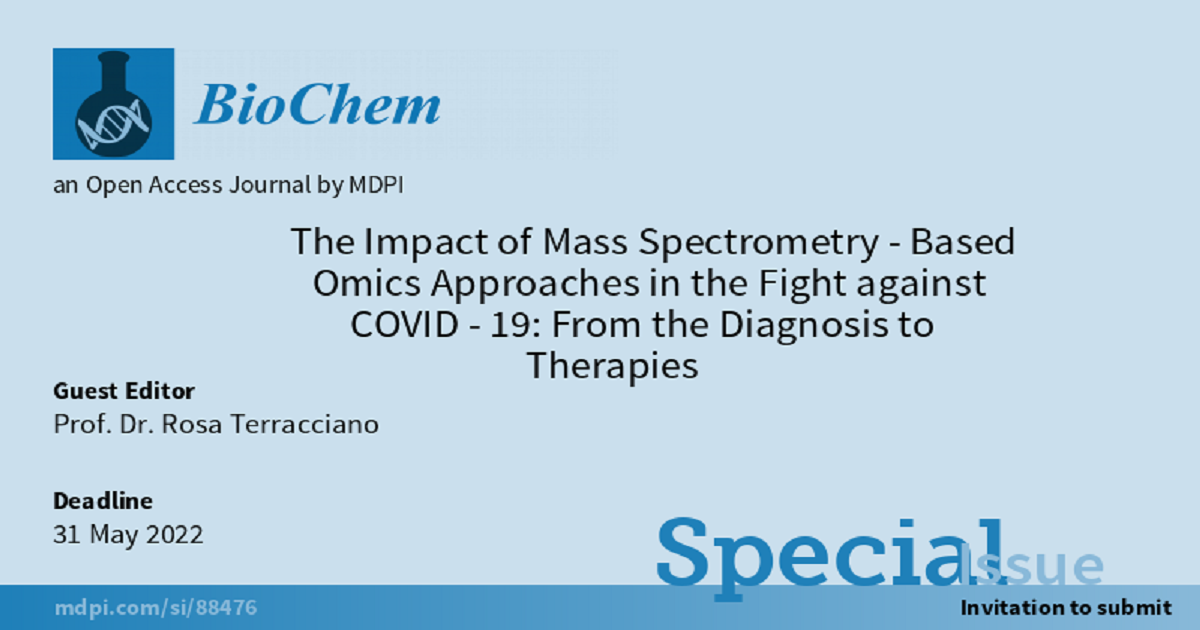The Impact of Mass Spectrometry-Based Omics Approaches in the Fight against COVID-19: From the Diagnosis to Therapies
A special issue of BioChem (ISSN 2673-6411).
Deadline for manuscript submissions: closed (31 May 2022) | Viewed by 22156

Special Issue Editor
Interests: proteomics; clinical proteomics; mass spectrometry; biomarker discovery; analytical chemistry; MALDI-TOF MS, proteins; peptides; proteome; organic chemistry
Special Issue Information
Dear colleagues,
There is an urgent need to better understand the molecular mechanisms involved in the SARS-CoV-2 life cycle and in its variants in order to fight the pandemic with appropriate diagnostic and therapeutic interventions. Mass-spectrometry-based proteomics has addressed and could further impressively address important issues including how to increase testing capacity, how the virus causes disease, which key regulators are implicated in the host response, what the cellular and systemic processes or pathways involved in the human immune system are, and many others. In the actual efforts to overcome COVID-19, however, additional studies are mandatory. This Special Issue will include articles and reviews that contribute through the means of proteomics and other integrated omics approaches to answer the various research questions around this pandemic.
Prof. Dr. Rosa Terracciano
Guest Editor
Manuscript Submission Information
Manuscripts should be submitted online at www.mdpi.com by registering and logging in to this website. Once you are registered, click here to go to the submission form. Manuscripts can be submitted until the deadline. All submissions that pass pre-check are peer-reviewed. Accepted papers will be published continuously in the journal (as soon as accepted) and will be listed together on the special issue website. Research articles, review articles as well as short communications are invited. For planned papers, a title and short abstract (about 250 words) can be sent to the Editorial Office for assessment.
Submitted manuscripts should not have been published previously, nor be under consideration for publication elsewhere (except conference proceedings papers). All manuscripts are thoroughly refereed through a single-blind peer-review process. A guide for authors and other relevant information for submission of manuscripts is available on the Instructions for Authors page. BioChem is an international peer-reviewed open access quarterly journal published by MDPI.
Please visit the Instructions for Authors page before submitting a manuscript. The Article Processing Charge (APC) for publication in this open access journal is 1000 CHF (Swiss Francs). Submitted papers should be well formatted and use good English. Authors may use MDPI's English editing service prior to publication or during author revisions.
Keywords
- mass spectrometry
- proteomics
- omics
- metabolomics
- lipidomics
- glycomics
- SARS-CoV-2
- COVID-19
- antiviral agents
- pharmacotherapy
- drug discovery
- protein–protein interactions
- virus–host interaction
- vaccine
- virus diagnosis
Benefits of Publishing in a Special Issue
- Ease of navigation: Grouping papers by topic helps scholars navigate broad scope journals more efficiently.
- Greater discoverability: Special Issues support the reach and impact of scientific research. Articles in Special Issues are more discoverable and cited more frequently.
- Expansion of research network: Special Issues facilitate connections among authors, fostering scientific collaborations.
- External promotion: Articles in Special Issues are often promoted through the journal's social media, increasing their visibility.
- Reprint: MDPI Books provides the opportunity to republish successful Special Issues in book format, both online and in print.
Further information on MDPI's Special Issue policies can be found here.




